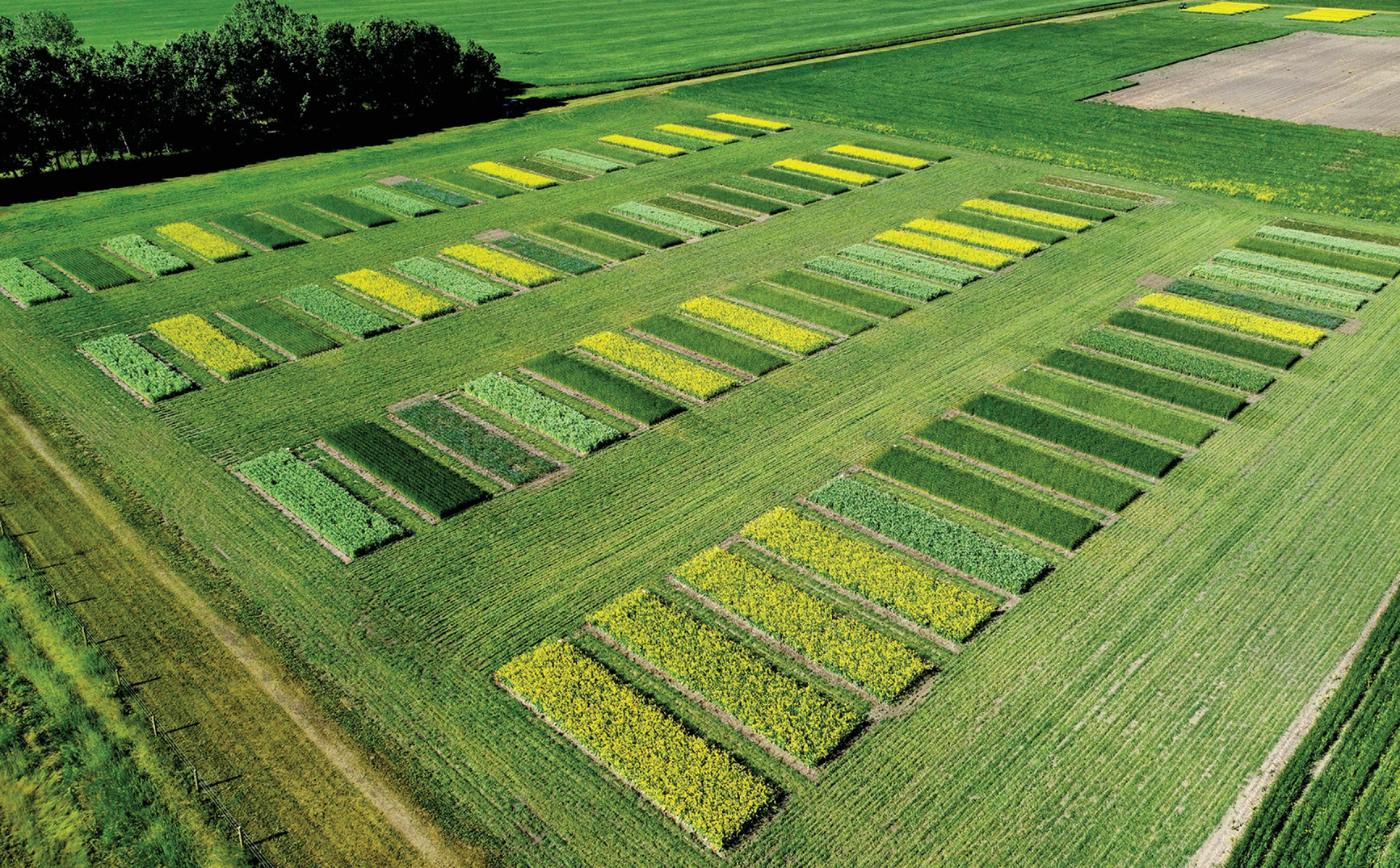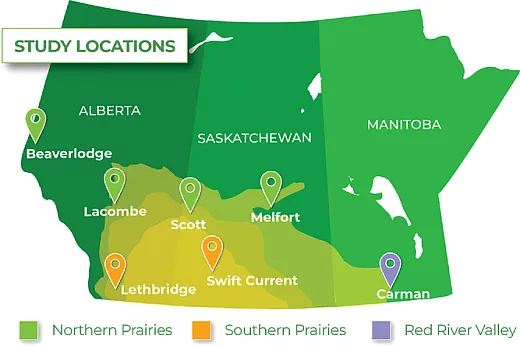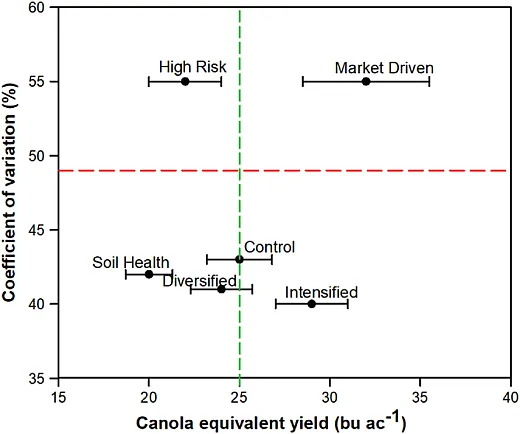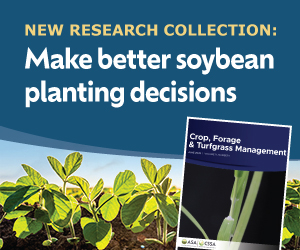Comparison of Integrated Crop Rotation Systems in Western Canada


Research has shown the benefits of diversifying crop rotations, yet many Prairie farmers keep their rotations short and simple with cereals and oilseeds or cereals and pulses being intensively grown in two-year rotations. As western Canadian farms are pressed to increase yields while reducing inputs and the environmental impact of food production, growers need help to determine what crop rotations can help them achieve these goals and remain economically viable. This article reports on research evaluating yield and yield stability, nitrogen use efficiency, and net economic returns of six crop rotations in the Southern Prairies, Northern Prairies, and Red River Valley ecozones of western Canada. Earn 0.5 CEUs in Crop Management by reading this article and taking the quiz.
On the Canadian Prairies, cereal–oilseed or cereal–pulse rotations are intensively grown, resulting in simple two‐year rotations. Studies have shown the benefit of diversifying cereal‐oilseed based production with the inclusion of pulses in the rotation (Niu et al., 2017; Liu et al., 2019). However, the pros and cons of various crop rotations need to be studied to understand the trade‐offs and to identify rotations that will be resilient in the face of more extreme growing conditions. Some crop rotations provide large benefits, but they may come at the expense of longer‐term system health. For example, increasing nitrogen (N) fertilizer to hybrid canola can significantly increase canola seed yield, but continuously doing so acidifies the soil over time (Meesenburg et al., 2016); inclusion of pulses reduces the use of synthetic N fertilizer application (Miller et al., 2003), but pulse‐intensified rotations lead to the buildup of disease‐causing pathogens in the soil (Bett & Banniza, 2014). Maintaining high productivity on the land, year‐after‐year, largely depends on soil quality and health (Malhi et al., 2007), but knowledge of options to maintain the soil quality and health in high‐yielding farm systems is limited.

To identify resilient rotations for the Canadian Prairies, research was undertaken in the Northern Prairies, Southern Prairies, and Red River Valley, over the past four years. There were seven sites (Figure 1). At each site, six crop rotations were evaluated. Crop species in the rotations were selected to be geographically relevant and therefore varied among sites (Table 1). The control rotation represents the traditionally recommended rotation in each ecozone; the pulse or oilseed intensified rotation is the typical rotation being grown in each ecozone; the diversified rotation includes multiple pulse species and/or winter cereals; the market‐driven rotation has crop types selected based on the highest commodity prices prior to planting; the high‐risk rotation includes new crop species that may require more or new resources in the form of genetics, agronomy, and equipment but could potentially result in high economic rewards; and the soil health rotation includes green manure and/or intercrops and/or winter cereals. Cropping system performance was assessed by measuring yield and yield stability, N use efficiency, and net economic returns.
| Northern Prairies (AB) rotation treatments | Year 1 | Year 2 | Year 3 | Year 4 |
|---|---|---|---|---|
| Control | Wheat | Pea | Wheat | Canola |
| Intensified | Wheat | Canola | Wheat | Canola |
| Diversified | Pea | Winter wheat | Faba bean | Canola |
| Market driven | Canola | Malt barley | Canola | Canola |
| High risk | Flax | Soybean | Durum | Canola |
| Soil health | Forage pea green manure | Winter wheat | Faba bean | Canola |
| Northern Prairies (SK) rotation treatments | Year1 | Year 2 | Year 3 | Year 4 |
| Control | Canola | Wheat | Pea | Wheat |
| Intensified | Canola | Wheat | Canola | Wheat |
| Diversified | Pea | Winter wheat | Faba bean | Canola |
| Market driven | Oat (Melfort) Canola (Scott) | Canola Wheat (Melfort) | Green pea (Scott) | Canola |
| High risk | Flax | Soybean | Durum | Canola |
| Soil health | Forage pea green manure | Winter wheat | Faba bean | Canola |
| Southern Prairies Rotation treatments | Year 1 | Year 2 | Year 3 | Year 4 |
| Control | Fallow | Durum | Malt barley | Durum |
| Intensified | Lentil | Durum | Chickpea | Durum |
| Diversified | Lentil | Canola | Pea | Durum |
| Market driven | Flax (Swift Current) Canola (Lethbridge) | Wheat Lentil (Swift Current) | Wheat (Lethbridge) Feed barley (Swift Current) | Malt barley (Lethbridge) |
| High risk | Soybean | Canary seed (Swift Current) | Corn (Lethbridge) | Faba bean Durum |
| Soil health | Forage pea green manure | Barley–pea intercrop | Faba bean–barley intercrop | Durum |
| Red River Valley rotation treatments | Year 1 | Year 2 | Year 3 | Year 4 |
| Control | Wheat | Soybean | Wheat | Canola |
| Intensified | Soybean | Wheat | Soybean | Canola |
| Diversified | Canola | Winter wheat | Soybean | Canola |
| Market driven | Corn | Corn | Oat | Canola |
| High risk | Corn | Dry bean | Canola | Sunflower |
| Soil health | Green manure | Fall rye | Corn–soybean intercrop | Canola–pea intercrop |
Yield and Yield Stability
Canola Equivalent Yield (CEY) allows for yield comparisons between different crop rotations by standardizing the crop rotation’s yield based on the price ratio of different crop types relative to canola (Liu et al., 2019). It is calculated as follows:
CEY = P non − canola/P canola × Y non − canola
where P non − canola is the price of non‐canola crops, P canola is the price of canola, and Y non − canola is the yield of non‐canola crops. The average price of each crop from 2017 to 2021 was used in CEY calculation. Based on the calculation, the CEY for a canola crop is the same as the canola grain yield.

Yield stability helps determine which rotations were consistently high or low yielding during the study period. This was based on the coefficient of variation (CV) of the rotation treatments across 27 site years. Rotations with a high CV and a low CEY are least favorable while rotations with a low CV and a high CEY are more favorable across diverse growing conditions (Figure 2).
In the Northern and Southern Prairies, there was rarely one rotation that was highest yielding (Table 2). In these ecozones, the high‐risk rotation had lower CEY in part due to the unsuitability of some crop species to these environments (such as soybean or durum in the Northern Prairies or faba bean in the Southern Prairies). In most Northern and Southern Prairie locations, rotations with three crop species and/or pulse species, were better‐performing rotations.
In the Red River Valley, higher CEYs in the high‐risk and market‐driven rotations were mainly driven by the inclusion of corn in those rotations. Corn was favored in these rotations during the drier and hotter 2019–2022 study period.
When assessing trends from all site‐years, the intensified rotation had relatively high yields combined with a low CV, giving it some of the most consistent yields over time and growing environments.
Rotation treatment | Northern Prairies | Southern Prairies | Red River Valley Carman | ||||
|---|---|---|---|---|---|---|---|
Beaverlodge | Lacombe | Scott | Melfort | Lethbridge | Swift Current | ||
————————————————————————————— CEY (bu/ac)————————————————————————————— | |||||||
| Site average | 27.1 | 50.9 | 27.4 | 30.4 | 14.0 | 24.3 | 29.5 |
| Control | 33.7 a | 47.7 bc | 31.0 b | 33.8 a | 14.6 ab | 19.9 c | 22.8 c |
| Intensified | 32.3 ab | 53.7 bc | 26.6 bc | 35.1 a | 17.3 a | 34.3 a | 25.6 c |
| Diversified | 27.7 ab | 56.2 ab | 22.6 cd | 30.1 b | 13.8 ab | 27.9 b | 21.5 c |
| Market driven | 27.6 ab | 63.1 a | 40.7 a | 30.8 ab | 16.7 ab | 29.9 ab | 37.5 b |
| High risk | 23.6 bc | 39.0 d | 24.0 cd | 27.6 b | 9.7 c | 16.1 c | 48.3 a |
| Soil health | 18.1 c | 45.6 cd | 19.7 d | 24.9 b | 12.0 bc | 17.8 c | 20.9 c |
Note. The initial multi-year ANOVA indicated a significant location x rotation treatment interaction; as such, ANOVA was conducted separately for each location. Within each site, CEYs followed by different letters are significantly different based on a Tukey mean separation at p = 0.05.
Nitrogen Use Efficiency
Nitrogen use efficiency (NUE) was calculated as the ratio of grain yield (expressed as canola equivalent yield, CEY) to available N (soil mineral N + applied N fertilizer). The method to determine the N fertilizer rates varied by crop rotation. They were based on soil test recommendations for target yields in each location, for each crop species, except for the market‐driven rotation treatment which received 1.2 times the recommended N fertilizer rate to maximize yield.
The diversified rotation had some of the highest NUE in the Northern and Southern Prairies (Table 3). In the Northern Prairies, this is likely attributed to having pulse crops in the rotation for two of four years and winter wheat, which is able to make use of available nitrogen late in the fall and early in the spring. In the Southern Prairies, the high NUE is likely attributed to having pulse crops in rotation for two of four years.
In the Red River Valley, the high risk rotation had the highest NUE, which is attributed to the high corn and sunflower yields in the rotation for two of four years.
In all ecozones, the soil health rotation significantly reduced the amount of N fertilizer applied compared with the control rotation. However, the soil health rotation did not have a high NUE because of its low yield (Table 2).
| Rotation treatment | Northern Prairies | Southern Prairies | Red River Valley Carman | ||||
|---|---|---|---|---|---|---|---|
| Beaverlodge | Lacombe | Scott | Melfort | Lethbridge | Swift Current | ||
| Site average | 0.28 | 0.34 | 0.30 | 0.22 | 0.14 | 0.28 | 0.28 |
| Control | 0.32 ab | 0.27 b | 0.25 b | 0.23 ab | 0.10 b | 0.19 c | 0.17 d |
| Intensified | 0.29 bc | 0.35 b | 0.27 ab | 0.22 ab | 0.19 a | 0.44 a | 0.26 bc |
| Diversified | 0.39 a | 0.48 a | 0.33 a | 0.26 a | 0.16 ab | 0.41 a | 0.21 cd |
| Market driven | 0.20 c | 0.31 b | 0.33 a | 0.17 b | 0.13 ab | 0.22 bc | 0.29 b |
| High risk | 0.25 bc | 0.30 b | 0.29 a | 0.20 b | 0.10 b | 0.20 c | 0.45 a |
| Soil health | 0.22 bc | 0.35 b | 0.28 ab | 0.21 b | 0.15 ab | 0.26 b | 0.25 bc |
Note. Within each site, NUE values followed by different letters are significantly different based on a Tukey mean separation at p = 0.05, except for
Lethbridge, which used a p = 0.01.
Net Economic Returns
Net revenue was calculated by determining the total value of the yield (based on average crop prices from 2012–2021) from each crop and subtracting total costs. Total costs include seed cost, fertilizer costs, pesticide costs, other variable costs (oil and fuel, machinery repair, transportation, labor, and interest), and fixed costs (land, machinery, and storage). Machinery costs were based on the average Saskatchewan farm size in 2021 of 1,766 acres (Saskatchewan Agriculture, 2021).
The average input costs of the six rotations were ranked in the order of soil health ($264/acre), diversified ($301/acre), control ($304/acre), high risk ($307/acre), intensified ($320/acre), and market driven ($338/acre).
In the Southern Prairies, the 2018–2021 growing seasons were drier than normal, and growth was unusually poor, resulting in most rotations producing negative net returns (Table 4). In environments with tendencies for harsh growing conditions, growers should focus on minimizing risk by selecting rotations with lower total costs. The intensified rotation (lentil–durum–chickpea–durum) seemed to perform better compared with other rotations and reflects common crop types grown in these areas.
Rotation treatment | Northern Prairies | Southern Prairies | Red River Valley Carman | ||||
|---|---|---|---|---|---|---|---|
Beaverlodge | Lacombe | Scott | Melfort | Lethbridge | Swift Current | ||
———————————————————————— Net economic returns ($/ac) ————————————————————————— | |||||||
| Site average | 5.79 | 122.78 | 4.94 | 36.34 | -208.42 | -5.03 | 4.17 |
| Control | 16.23 ab | 107.10 bc | 24.42 b | 70.95 a | -175.67 a | -31.31 a | -51.10 d |
| Intensified | -29.40 bc | 120.20 b | -21.22 c | 66.17 a | -177.88 a | 69.62 a | 0.69 c |
| Diversified | 57.38 a | 114.84 b | -30.88 c | 63.09 a | -211.23 b | 5.58 c | -62.85 d |
| Market driven | 18.63 ab | 233.73 a | 109.56 a | -3.14 b | -225.50 b | 44.71 b | 88.40 a |
| High risk | 22.50 ab | 107.12 bc | -19.20 c | 7.62 b | -281.80 c | -98.29 e | 58.83 b |
| Soil health | -50.59 c | 53.68 c | -33.03 c | 13.32 b | -178.45 a | -20.50 d | -8.95 c |
Note. Within each site, net economic returns followed by different letters are significantly different based on a Tukey mean separation at p = 0.05.
In the Northern Prairies, the higher net returns often associated with the market‐driven rotation are attributed to the high frequency of canola in the rotation and the high canola crop prices. It is important to note that the market‐driven rotation often has canola being grown in three of four years, which is an agronomically risky practice that is not recommended due to the long‐term impacts of canola disease buildup in short rotations. The soil health rotation consistently has some of the lowest net returns due to the lack of yield in the green manure year of the rotation, resulting in no saleable grain in one of four years.
In the Red River Valley, the market‐driven and high‐risk rotations have the most profitable net returns. This was attributed to high corn yields in these rotations. From a risk management perspective, it is important to note that the market‐driven rotation also has the highest input costs. Field seasons at Carman were drier than average; if growing conditions were more typical for the region, the other rotations may have had more competitive net returns.
Summary
Depending on a producer’s goal, there are different optimum rotations. In most Northern and Southern Prairie locations, rotations with three crop species and/or pulse species, were better–performing rotations. However, it is important to select species well adapted to the growing area with high yield potential.
The canola–wheat intensified rotation in the Northern Prairies and the pulse–wheat intensified rotation in the Southern Prairies are very reflective of farmer practice in these areas and are also some of the most consistently high‐yielding rotations year over year.
If NUE is the ultimate goal, rotations with pulse crops being grown in two years of a four‐year rotation are ideal choices for the Northern and Southern Prairies. Inclusion of winter wheat, which makes use of nitrogen late in the fall and early in the spring, can also help improve NUE.
Although rotations with three of four years in canola were economically favorable, there is risk associated with the long‐term impacts of canola disease buildup in short rotations. However, these findings explain why many areas in the Northern Prairies have tight canola rotations.
Net economic returns were negative for most rotations when precipitation was well below average in the Southern Prairies. In these challenging ecozones, the intensified rotation (lentil–durum–chickpea–durum) seemed to perform better compared with other rotations and reflects common crop types grown in these areas.
In the Red River Valley, the high yields of corn, relative to other crop species, resulted in the highest CEY, NUE, and net economic returns for the high‐risk and market‐driven rotations. Having well‐adapted crop species that yield well under a range of precipitation regimes is important to maximize rotation performance.
The poor performance of the soil health rotation, as assessed by all metrics, was driven by the lack of saleable yield in one of the four years of the rotation. For increased adoption of the soil health rotation, other positive metrics, or other means of financial compensation, will be required. These results are based on the first four years of the study. More robust results are expected if a second four‐year cycle of the study is completed. Funding for a second four‐year cycle will be confirmed in 2023.
DIG DEEPER
For more details on this study, see:
Lasisi, A. & Liu, K. (2023). A global meta‐analysis of pulse crop effect on yield, resource use, and soil organic carbon in cereal‐ and oilseed‐based cropping systems. Field Crops Research, 294. https://doi.org/10.1016/j.fcr.2023.108857e
Acknowledgments
This research is supported by funding from Western Grains Research Foundation, Alberta Wheat, Sask Wheat, Alberta Pulse Growers, SaskCanola, Manitoba Crop Alliance, and Agriculture and Agri‐Food Canada through the Canadian Agricultural Partnership—a provincial‐federal‐territorial initiative.
References
Bett, K.E., & Banniza, S. (2014). Population study of Xanthomonas spp. from bean growing regions of Canada and response of bean cultivars to pathogen inoculation. Canadian Journal of Plant Pathology, 36, 341–353. https://doi.org/10.1080/07060661.2014.925000
Liu, K., Johnson, E.N., Blackshaw, R.E., Hossain, Z., & Gan, Y. (2019). Improving the productivity and stability of oilseed cropping systems through crop diversification. Field Crops Research, 237, 65–73. https://doi.org/10.1016/j.fcr.2019.03.020
Malhi, S.S., & Lemke, R. (2007). Tillage, crop residue and N fertilizer effects on crop yield, nutrient uptake, soil quality and nitrous oxide gas emissions in a second 4‐yr rotation cycle. Soil and Tillage Research, 96, 269–283. https://doi.org/10.1016/j.still.2007.06.011
Meesenburg, H., Ahrends, B., Fleck, S., Wagner, M., Fortmann, H., Scheler, B., Klinck, U., Dammann, I., Eichhorn, J., Mindrup, M., & Meiwes, K.J. (2016). Long‐term changes of ecosystem services at Solling, Germany: Recovery from acidification, but increasing nitrogen saturation? Ecological Indicators, 65, 103–112. https://doi.org/10.1016/j.ecolind.2015.12.013
Miller, P.R., Gan, Y., McConkey, B.G., & McDonald, C.L. (2003). Pulse crops for the northern Great Plains: I. Grain productivity and residual effects on soil water and nitrogen. Agronomy Journal, 95, 972–979. https://doi.org/10.2134/agronj2003.9720
Niu, Y., Bainard, L.D., Bandara, M., Hamel, C. & Gan, Y. (2017). Soil residual water and nutrients explain about 30% of the rotational effect in 4‐yr pulse‐intensified rotation systems. Canadian Journal of Plant Science, 97, 852–864. https://doi.org/10.1139/cjps‐2016‐0282
Saskatchewan Agriculture. (2021). 2020–2021 farm machinery custom and rental rate guide. Government of Saskatchewan. https://publications.saskatchewan.ca/#/products/76527
Self-Study CEU Quiz
Earn 0.5 CEUs in Crop Management by taking the quiz. For your convenience, the quiz is printed below. The CEU can be purchased individually, or you can access as part of your Online Classroom Subscription.
- In the Northern and Southern Prairies, soybean was included in which rotation?
- Intensified.
- Diversified.
- Market driven.
- High risk.
- Soil health.
- Across all site-years, the _________ rotation had relatively high yields combined with a low coefficient of variation (CV), giving it some of the most consistent yields over time and growing environments.
- intensified
- diversified
- market driven
- high risk
- soil health
- In the Red River Valley, which rotation had the highest nitrogen use efficiency (NUE)?
- Intensified.
- Diversified.
- Market driven.
- High risk.
- Soil health.
- Which rotation had the lowest average input costs?
- Intensified.
- Diversified.
- Market driven.
- High risk.
- Soil health.
- In most Northern and Southern Prairie locations, rotations with ______ crop species and/or pulse species were better performing rotations.
- one
- two
- three
- four
Text © . The authors. CC BY-NC-ND 4.0. Except where otherwise noted, images are subject to copyright. Any reuse without express permission from the copyright owner is prohibited.










